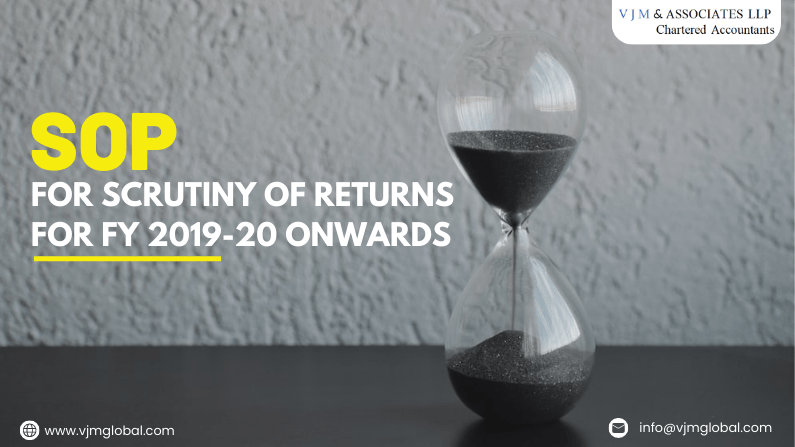CBIC issued Standard Operating procedure (SOP) for scrutiny of returns u/s 61 of CGST Act read with Rule 99 of CGST Rules, 2017 for FY 2017-18 and FY 2018-19 through Instruction No. 02/2022-GST dated March 22, 2022. However, It was mentioned in the instructions that the SOP was a temporary solution until an online Scrutiny Module for scrutinizing returns is made available on the ACES-GST application.
As announced, DG Systems has developed a new feature called “Scrutiny of Returns” in the CBIC ACES-GST application. Advisory has also been issued along with a User Manual that explains the workflow of this feature in detail. Additionally, the GSTINs selected for scrutiny for the Financial Year 2019-20 are now accessible on the scrutiny dashboard of the proper officers on the ACES-GST application.
The new functionality allows the proper officer to communicate any discrepancies found in the returns to the registered person using FORM GST ASMT-10. The registered person can respond by submitting a reply using FORM GST ASMT-11. Based on reply, the proper officer can issue an order in FORM GST ASMT-12 or take further action such as issuing a show cause notice under Section 73 or 74 of the CGST Act, 2017, or referring the matter for audit or investigation, as needed.
Read Also: GST on goods sent outside India under sale or approval basis
Accordingly, CBIC has issued the following revised Standard Operating Procedure (SOP) for scrutiny of returns for FY 2019-20 onwards through Instruction No. 02/2023-GST dated 26th May 2023:
1. Selection of returns for scrutiny and communication of the same to the field formations
- Directorate General of Analytics and Risk Management (DGARM) will select the GSTINs registered with Central Tax authorities for scrutiny based on identified risk parameters.
- Selected GSTINs will be displayed on the scrutiny dashboard of the proper officer on the ACES-GST application.
- The scrutiny dashboard will also show risk parameters identified for a particular GSTIN, such as Revenue Implication, ITC Mismatch, etc, and the tax/discrepancy amount associated with such GSTIN.
- However, It’s important to note that this data is generated at a specific point of time and may change during scrutiny of return due to subsequent compliances carried out by the taxpayer or by the supplier of the taxpayer.
- Therefore, The proper officer should refer to the latest data available.
2. Scrutiny Schedule
- Once the selected GSTINs’ details are available on the scrutiny dashboard of the proper officer on the ACES-GST application, The officer will finalize a scrutiny schedule with the approval of the divisional Assistant/Deputy Commissioner.
- The scrutiny schedule is a month-wise plan for scrutinizing all the selected GSTINs prepared by the proper officer and is contains the following information: (As per Instruction 02/2022- GST dated 22nd March 2022)
- ZCDR Code
- FY
- GSTIN
- Month in which GST ASMT-10 is proposed to be issued
- GSTIN appearing risker, i.e., involving high revenue implications, will be prioritized.
- The Principal Commissioner/Commissioner will regularly monitor the progress of the scrutiny exercise according to the scrutiny schedule.
- The proper officer will scrutinize returns of minimum 4 GSTINs per month. Scrutiny of return of one GSTIN shall mean scrutiny of all returns of the selected financial year.
3. Process of scrutiny by the Proper Officer
- The Proper Officer will verify the correctness of the returns and related information provided by the registered person.
- For this purpose, proper officer can rely on information available through various sources like DGARM, ADVAIT, GSTN, E-Way Bill Portal, returns and statements submitted by the registered person etc.
- For convenience purpose, details of risk parameters and amount of tax/ Discrepancy involved shall be provided to the proper officer. Proper officer may consider any other data as he deems fit.
- At the initial phase of scrutiny, the proper officer should rely on information available with him on records. Proper officer and registered person should have minimal interface and, there should normally not be any need for seeking documents/ records from the registered persons before issuance of FORM GST ASMT-10.
a. Issuance of Notice in Form GST ASMT-10
- The proper officer shall issue a notice to the registered person in FORM GST ASMT-10 through the scrutiny functionality on ACES-GST application.
- Notice shall contain information about discrepancies and tax involved.
- If a registered person has made any additional payment of tax, cess, interest, etc. after filing of the returns for the relevant tax period through FORM DRC-03 then such payment should be taken into consideration while communicating discrepancies to the taxpayer in FORM GST ASMT-10.
- GST ASMT-10 shall be communicated by the system to the concerned registered person on the common portal. Therefore, there is no need to send manual communication.
- Proper officer should quantify the tax, interest and any other amount payable in GST AMST-10 and such calculations should be specific in nature and not vague or general.
- The proper officer shall mention the parameter-wise details of the discrepancies noticed by him in FORM GST ASMT-10 and shall also upload the worksheets and supporting document(s)/ annexures, if any.
- GST ASMT-10 shall be issued based on scrutiny of all returns pertaining to the relevant Financial year.
b. Reply by the registered person in Form GST ASMT-11
- On receipt of notice, the registered person may accept the discrepancy mentioned in the notice and pay the amount specified in notice.
- Post payment, a registered person may inform the proper officer about tax payment in Form GST ASMT-11.
- In case of non-acceptance, the registered person may furnish his reply in Form GST ASMT-11.
- The reply in form FORM GST ASMT-11 shall be made available to the concerned proper officer in the scrutiny dashboard on the ACES-GST application.
c. Proceedings drop in Form GST ASMT-12
- Where response furnished by the registered person is found to be acceptable by the proper officer, he shall conclude the proceedings by informing the registered person in FORM GST ASMT-12.
d. Issuance of Show Cause Notice in Form DRC-01
- If no satisfactory explanation is furnished within the permitted time period or where the registered person accepts the discrepancies but fails to pay the amount then the proper officer may issue the show cause under section 73 or section 74 of CGST Act.
- For proceedings under section 73 or section 74 of CGST Act, monetary limits specified in Circular No. 31/05/2018-GST dated 9th February 2018 shall be adhered to.
- Also, the proper officer may refer the matter for audit or investigation to determine the correct liability with approval of the jurisdictional Principal Commissioner / Commissioner through the divisional Assistant/ Deputy Commissioner.
- The copy of the approval is to be uploaded while referring the matter to the concerned formation through the scrutiny functionality, as per the procedure detailed in the user manual issued by DG Systems.
Read about how to handle notice issued in form GST ASMT-10
4. Timelines for scrutiny of returns
Proper officer is required to complete each and every process in a time bound manner so that matters can reach their logical conclusion in a time bound manner. The following are time lines to be adhered to:
| Process | TimeLine |
| Communication of GSTINs selected for scrutiny by DGARM on ACES GST Application for a financial year | From time to time |
| Finalization of scrutiny schedule with the approval of the concerned Assistant/ Deputy Commissioner | Within 7 working days of receipt of the information about such GSTIN. |
| Issuance of notice by the proper officer in FORM GST ASMT-10, where required | Within the timeline given in the scrutiny schedule. |
| Reply by the registered person in FORM GST ASMT-11 | Within 30 days of issuance of form GST ASMT-10. Such period may further be extended |
| Order in FORM GST ASMT12 for acceptance of reply furnished by the registered person | Within 30 days from receipt of reply in FORM GST ASMT11 |
| If no reply is furnished, Initiation of proceedings under section 73 or section 74 | Within 15 days from expiry of time period given in GST ASMT-10. |
| If reply is not found satisfactory, Initiation of proceedings under section 73 or section 74 | Within 30 days of receipt of reply in FORM GST ASMT11 |
| Reference, if any, to the Audit Commissionerate or the anti-evasion wing of the Commissionerate for action under section 65 or section 66 or section 67, as applicable. | Within 30 days of receipt of reply in FORM GST ASMT11.Within 45 days of issuance of FORM GST ASMT-10, if no reply is furnished. |
5. Reporting and Monitoring
- The scrutiny dashboard on the ACES-GST application will provide two MIS reports to track the actions taken by the proper officer for the allocated GSTINs:
- “Monthly Scrutiny Progress Report” summarizes the status of return scrutiny for each selected month and formation.
- “Scrutiny Register” provides detailed GSTIN-wise information on the actions taken during the scrutiny of returns.
- From the FY 2019-20 onwards, there is no need for CGST zones to compile and send the Monthly Scrutiny Progress Report to DGGST.
- However, for the FY 2017-18 and 2018-19, the CGST zones will continue to send the Monthly Scrutiny Progress Reports to DGGST until the scrutiny process is completed for these years.
- The jurisdictional Principal Commissioner/Commissioner will regularly monitor the progress of the scrutiny exercise according to the scrutiny schedule.
- The scrutiny functionality on the ACES-GST application is available only for the Financial Year 2019-20 onwards. Therefore, scrutiny of FY 2017-18 and 2018-19 will be carried out as per Instruction No. 02/2022 dated 22.03.2022.
- The online scrutiny on ACES-GST will enhance technology-driven compliance and minimize interaction in return scrutiny. PCCs/CCs of CGST Zones must monitor the timely scrutiny of selected GSTINs within their jurisdiction.













